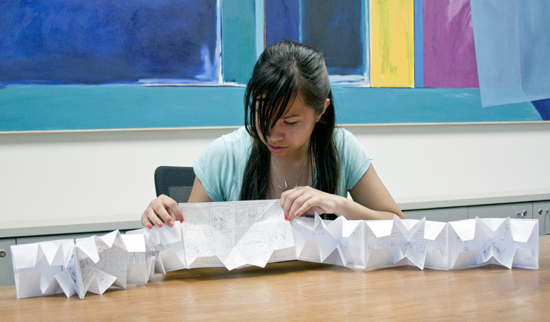Although majoring in art would never have pleased her parents, Kim Sazon’s love for making comic books and cartoons as a child and throughout high school inevitably stuck by her.
Though she is a first-year business economics student, Sazon enrolled in “Artists’ Books in the UCLA Library and Beyond,” a Fiat Lux on the history and creation of an artist’s book.
An artist’s book is an ambiguous form of art that allows the artist to have complete creative freedom. Many artists’ books come in the form of a pop-up book, an accordion-style book or a book without binding. A book can contain photography, poetry, illustrations, excerpts cut out from pages of other books and any other means that the artist wants to include, said Robert Gore, the visual arts librarian of the arts library and the professor of the Fiat Lux on artists’ books. Many artists do not concern themselves with the final product but rather with the process of creation.
“The sky is literally the limit,” Gore said. “There is nothing restricting you.”
Since Sazon was initially uncertain about the subject of her artist’s book, Gore recommended that she start by thinking about her own life.
Sazon’s artist’s book is a pop-up book with scenes portraying the personalities and pranks of her floormates on the third floor of De Neve’s Evergreen building. As a tribute, her artist’s book is entitled “E3.” The book is based on the whimsical style of some artists’ books and incorporates origami in its paper engineering that contributes to the book’s pop-up quality. Sazon estimates she spent a total of 50 hours creating her artist’s book.
Although there is evidence that artists’ books existed during the medieval period, most researchers depict William Blake, the English artist and poet, as being the first leading creator of artist’s books in the late 18th century, Gore said.
Four UCLA libraries house a large collection of artists’ books: the Biomedical Library, Arts Library, William Andrews Clark Memorial Library and Young Research Library’s special collections. The Arts Library, in particular, houses thousands of artists’ books and boasts one of the largest collections in North America, Gore said.
The Fiat Lux class visited many of these exhibitions, exposing students to different forms of artists’ books. The class also heavily incorporated notable guest speakers such as Johanna Drucker, a professor in the Department of Information Studies at UCLA, who has made many influential artist’s books.
Almost all of the artists’ books in the various libraries on campus are considered “closed stacks,” meaning that they cannot be checked out because of their unique and delicate nature. Artists’ books also vary immensely on price, ranging from $10 to $5,000, Gore said.
Artists’ books are not usually financed by state funds but rather by endowment funds financed by donors.
As the history and special collections librarian for the Biomedical Library since the 1990s, Russell Johnson has seen a different variety of artists’ books that give new meaning to their importance. Biomedical artists’ books often touch upon the themes of pain and pain treatment, he said. Scientific artists’ books are often able to visually express and educate the public about a subject that is usually taught in a more traditional manner. Although many artists who create scientific artists’ books do not have a scientific background, they often dive into scientific research in the process of creating their artists’ books.
“Many artists of this genre dive into the old science and make something new or progress the science even further,” Johnson said.
Johnson also emphasized that although most artists’ books cannot be checked out, the libraries buy them for the sole purpose of research and inspiration.
Kendra Knudsen, a second-year psychobiology student, took Gore’s Fiat Lux in the fall of her first year. Although Knudsen was already artistically inclined, she found that the Fiat Lux not only brought a group of people with varying backgrounds together to socialize and form great relationships, but also taught her that artists’ books are a unique way of distributing ideas that are often pertinent to everyone in one way or the other.
“This class is important for artists and non-artists alike because it emphasizes not confining yourself in expression,” she said. “Artists’ books are mass produced so they are more likely to get the word out on issues relevant to politics and society shown through artistic expression.”
The Fiat Lux inspired Knudsen to continue with art and to pursue artists’ books as a three-dimensional method of expressing her talent of painting.
The process of creating her artist’s book encouraged Sazon to consider continuing to create artists’ books with the hope of one day becoming published and the financial rewards she could reap as a result.
“As an artist, I could get exposure through artists’ books,” Sazon said. “I want to apply my artistic side while still pursuing my academics.”
Although UCLA does not offer a course solely dedicated to artists’ books aside from the Fiat Lux, Gore contends artists’ books are one of the most versatile forms of art in its diversity of content, theme and form.
“I find that artists’ books are a very democratic form of art,” Gore said. “Anyone can make an artist’s book.”
